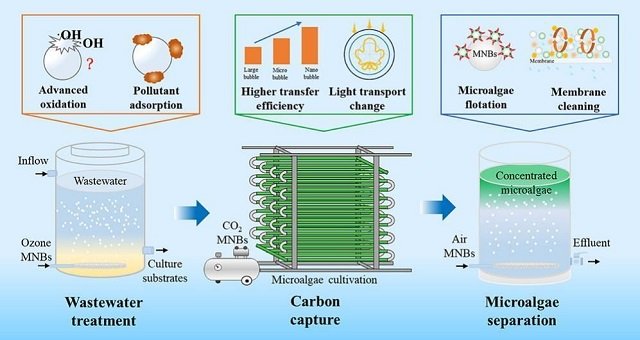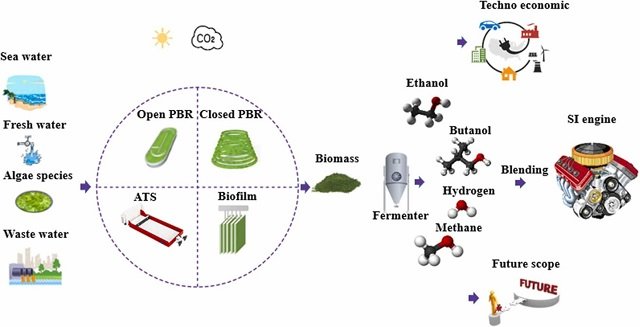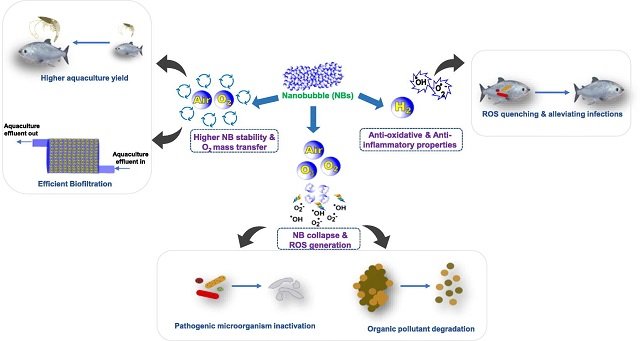
The world stands at a crossroads. Fossil fuels have driven our progress but have also triggered a climate crisis. As temperatures rise and extreme weather becomes the norm, we desperately need solutions. Enter microalgae, microscopic wonders with the power to capture carbon dioxide and produce sustainable biofuels.
But how do we unlock their full potential? This is where micro-nano bubbles (MNB) come in.
Scientists from Tongji University, the State Key Laboratory of Pollution Control and Resource Reuse, and the Key Laboratory of Rural Toilet and Sewage Treatment Technology of the Ministry of Agriculture and Rural Affairs have published a scientific review to understand how microalgae can revolutionize the industry. Not only for carbon capture but also for a variety of valuable products such as biofuels, fertilizers, and even food. It’s time to embrace the power of the small, to witness how microalgae armed with their MNB superpowers cleanse the skies and pave the way for a greener future.
The bottleneck: Getting enough CO2 for microalgae
Microalgae are nature’s CO2-devouring machines. They feed on carbon dioxide, fix it into biomass, and release oxygen into the atmosphere. This natural process has immense potential to mitigate climate change. Microalgae can capture 10 times more CO2 than terrestrial plants!
But there’s a problem. For microalgae to thrive, they need efficient access to CO2. Traditionally, this involves bubbling gas into microalgae cultivation tanks. However, these bubbles often rise and escape before microalgae can fully utilize them. This is where micro-nano bubbles come into play.
Micro-nano Bubbles (MNB)
Imagine bubbles so tiny they are barely visible: that’s the magic of MNB. Thanks to their minuscule size, they have a huge surface area for CO2 to adhere to, enhancing gas-liquid transfer and feeding our microalgae friends with a CO2 feast. But their benefits go beyond simple carbon capture.
The benefits of micro-nano bubbles in microalgae cultivation include:
- Increased CO2 capture: MNB can boost CO2 absorption by microalgae by up to 300%, significantly improving their carbon capture potential.
- Improved microalgae growth: With more CO2 available, microalgae grow faster and produce more biomass, making them more efficient biofuel producers.
- Paving the way for wastewater treatment: Wastewater can be used as a nutrient source for microalgae, but its complexity can hinder growth. MNB can be used to pretreat wastewater, removing harmful substances and making it suitable for microalgae cultivation.
- Reduced membrane fouling: Microalgae separation often involves membranes, which can clog with impurities. MNB can help prevent this, streamlining the process and reducing costs.
- Enhanced flotation: Microalgae harvesting can be challenging. MNB can attach to microalgae cells, making them float to the surface for easier collection.
Unleashing the future of sustainability
While MNB offers a promising solution, much is still unexplored. Research is needed to optimize MNB generation, integrate them into existing microalgae cultivation systems, and explore new applications like bioremediation and food production.
Stay Always Informed
Join our communities to instantly receive the most important news, reports, and analysis from the aquaculture industry.
Despite their undeniable potential, researchers are still uncovering the secrets of MNB. The scientific review delves into:
- The unique properties of MNB and their role in enhancing CO2 capture.
- Effective generation methods to produce a steady flow of these tiny bubbles.
- The intricate mechanisms through which MNB drive gas-liquid mass transfer and unleash the full carbon capture potential of microalgae.
- Synergistic effects of MNB in wastewater pretreatment and microalgae separation.
Harnessing the power of these small bubbles, we can unlock the true potential of microalgae and pave the way for a more sustainable future. So, the next time you see a unicellular marvel, remember: that it could be the key to solving some of our greatest environmental challenges.
Conclusion
“There is a growing research interest in improving microalgae production processes and carbon capture with MNB technology. MNB promotes the degradation of complex matrices of wastewater through oxidizing gases like ozone, thereby improving the biochemistry of microalgae from wastewater,” conclude the scientists.
The synergy between microalgae and micro-nano bubbles offers a glimpse of a future where we can combat climate change, clean our water, and produce sustainable resources. Harnessing the power of these small titans, we can pave the way for a greener, cleaner, and more resilient planet.
The study was funded by the National Natural Science Foundation of China, Shanghai Science and Technology Innovation Action Plan, China Baowu Low Carbon Metallurgy Innovation Foundation, Sino-German Cooperation 2.0 Strategic Support Program Project of Tongji University, and the State Key Laboratory of Pollution Control and Resource Reuse.
Contact
Yalei Zhang
College of Environmental Science and Engineering,
Tongji University, Shanghai 200092, China.
Email: zhangyalei@tongji.edu.cn
Reference
Xiaogang You, Libin Yang, Huaqiang Chu, Lei Zhang, Yongyuan Hong, Yi Lin, Xuefei Zhou, Yalei Zhang. 2024. Micro-nano-bubbles and their application in microalgae production: Wastewater treatment, carbon capture and microalgae separation, Algal Research, 2024, 103398, ISSN 2211-9264, https://doi.org/10.1016/j.algal.2024.103398.
Editor at the digital magazine AquaHoy. He holds a degree in Aquaculture Biology from the National University of Santa (UNS) and a Master’s degree in Science and Innovation Management from the Polytechnic University of Valencia, with postgraduate diplomas in Business Innovation and Innovation Management. He possesses extensive experience in the aquaculture and fisheries sector, having led the Fisheries Innovation Unit of the National Program for Innovation in Fisheries and Aquaculture (PNIPA). He has served as a senior consultant in technology watch, an innovation project formulator and advisor, and a lecturer at UNS. He is a member of the Peruvian College of Biologists and was recognized by the World Aquaculture Society (WAS) in 2016 for his contribution to aquaculture.




